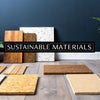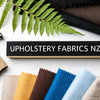Your Guide to Upholstery Fabrics NZ
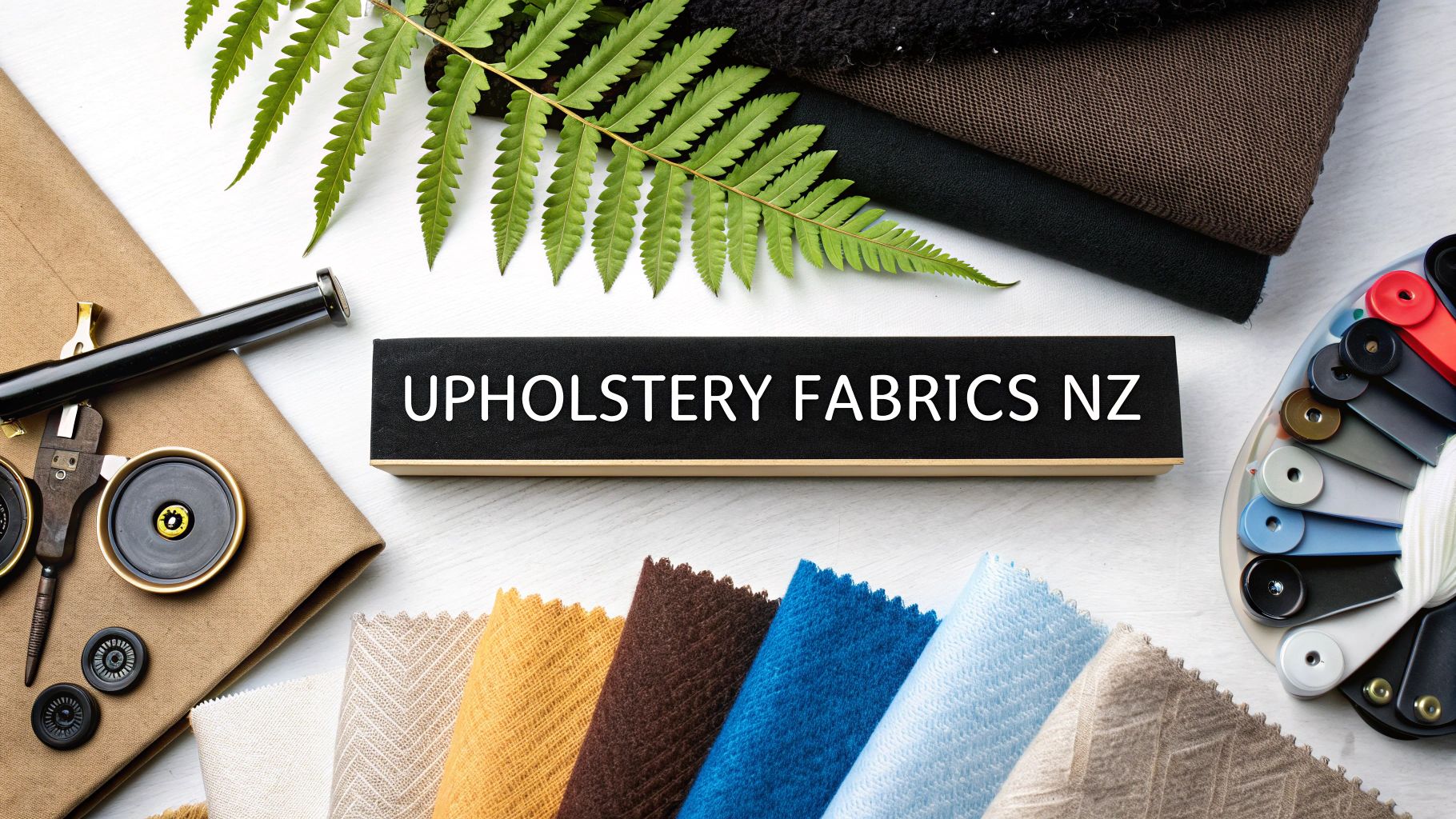
Picking the right upholstery fabric for your home here in NZ isn't just about what looks good – it's about finding that sweet spot between style, your lifestyle, and even your home's location. The perfect choice has to feel right in your space but also be tough enough for real Kiwi life, whether it's for the family sofa that sees all the action or a beautiful armchair tucked away in a quiet corner.
How to Choose the Right Upholstery Fabric in NZ
Starting a reupholstery project is always exciting. But let's be honest, staring at a wall of fabric samples can feel a bit much. The trick is to think beyond just a pretty pattern or a colour you love. You need to channel your inner designer and really consider how your furniture is used every single day.
A truly great fabric choice is where beauty and practicality meet. To get there, you just need to ask yourself a few simple questions. Your answers will narrow down the options in no time, making the whole process much easier.
Key Questions to Ask Before You Buy
- Who’s actually using it? A sofa in a busy lounge with kids, pets, and dropped popcorn has completely different demands than a formal armchair that only gets used when guests are over. Be realistic!
- How much action will it see? Pieces that get a lot of daily love need fabrics with serious durability and stain resistance. For items that are more for show, you can get away with something a bit more delicate.
- Where is the furniture going to live? The New Zealand sun can be incredibly harsh, and some fabric dyes will fade faster than you can say "G&T". If your piece is destined for a sunny spot, you'll want to look for fabrics with high UV resistance.
- What’s the climate like? In more humid, coastal spots like Auckland or the Bay of Plenty, breathable fabrics are your friend. Think linen or some of the clever new performance synthetics that help prevent that stuffy, mildewy feeling and are much nicer to sit on.
Your Secret Weapon for Durability
Now, let's talk about one of the most useful things to understand when picking upholstery fabrics in NZ: the "rub count". It might sound like industry jargon, but it’s the single best clue you have to a fabric's real-world toughness.
The rub count, which comes from something called the Martindale test, literally measures how many times a fabric can be rubbed before it starts to show wear and tear. It’s basically a lifespan score for your fabric.
A higher number means a more robust material, ready to handle all the sitting, shifting, and general life you can throw at it.
Here’s a quick guide to matching the rub count to your furniture:
- Decorative (under 10,000 rubs): Perfect for things that are more for looking at than for using, like a bedroom chair or a few throw cushions.
- Light Domestic (10,000 - 15,000 rubs): Good for furniture that sees occasional use, like the chairs in a formal dining room.
- General Domestic (15,000 - 25,000 rubs): This is the sweet spot for most homes. It's ideal for living room sofas and chairs that get used regularly.
- Heavy Duty (25,000+ rubs): The absolute champion. This is what you want for your main family sofa, an armchair that’s everyone's favourite, or any piece that has to stand up to constant use.
By checking that the rub count fits what you need, you’re not just choosing a fabric that looks amazing on day one—you’re making sure it stays that way for years to come.
Exploring Natural Upholstery Fabrics
When you're looking for upholstery fabrics in NZ, there's something about natural fibres that just feels right. It's like coming home. Materials like cotton, linen, wool, and silk have a timeless character that synthetic options are always trying to copy. They bring a little piece of the natural world inside, offering textures and performance that really suit the Kiwi way of life.
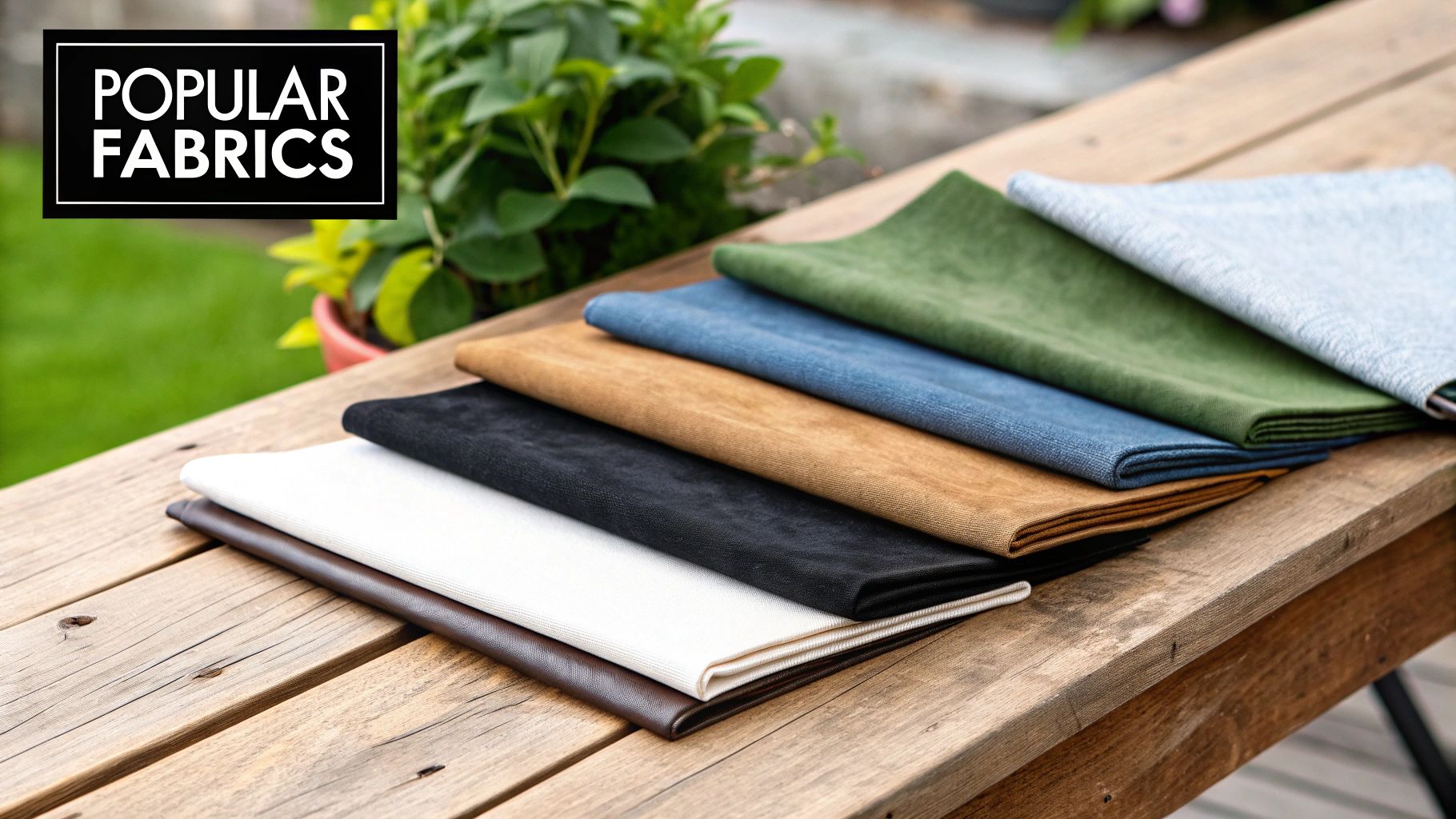
But it's not just about looks. These fabrics feel and perform differently depending on our unique environment. From the humid summers up North to the crisp winters down South, natural fibres have distinct advantages that make them both a practical and beautiful choice for any New Zealand home.
The Charm and Challenge of Linen
Linen is the ultimate ‘coastal bach’ fabric. It's got that effortlessly elegant, slightly crumpled vibe that just says "relax". Linen is also incredibly breathable, making it a fantastic choice for our warmer spots. It wicks moisture away and feels lovely and cool against the skin on a hot day.
Of course, linen isn't without its quirks. It wrinkles very easily, which is part of its casual charm for some, but maybe not if you’re after a more formal, tidy look. It’s also prone to fading under our intense Kiwi sun, so it’s best for furniture that’s kept out of direct sunlight or in rooms with good UV protection on the windows.
The Enduring Strength of Wool
Wool is the perfect ‘South Island winter’ fabric. Just picture it: sinking into a cosy wool armchair by the fire. It’s a material that truly embodies warmth and comfort. As a brilliant natural insulator, wool is ideal for creating a snug, inviting atmosphere in cooler homes.
But its benefits go way beyond just being cosy. Wool is unbelievably durable. Its natural elasticity means it resists creasing and holds its shape for years, even with heavy use. It’s also naturally flame-retardant and even has some moisture-wicking properties, making it a tough and safe choice for a busy family home.
Key Insight: Wool has this amazing natural structure of overlapping scales that act like a shield, repelling dirt and stains. This means spills often sit right on the surface, giving you a chance to blot them away before they sink in. It's much easier to clean than you might think!
Cotton and Silk Considerations
Cotton is another popular go-to. It's known for being soft, breathable, and taking on colour beautifully, so it offers a comfortable and familiar feel. The only catch is that standard cotton can stain and fade quite easily. You'll often find it blended with other fibres to boost its durability, especially for furniture that gets a lot of use.
Then there's silk. It’s pure luxury. Nothing quite matches its beautiful sheen and soft touch, making it perfect for an elegant accent chair or cushions in a quiet, low-traffic spot. But this beauty is delicate; silk just isn't built for the rough and tumble of daily life and needs a professional to clean it properly.
The wider textile market here in New Zealand is currently navigating a tricky balance between cost and quality. While the Manchester retail industry, which includes upholstery, has seen a modest revenue growth of 2.1% annually over the past five years, rising living costs mean many of us are having to prioritise price. This can definitely sway the final fabric choice. You can dig into the details by exploring the full report on the NZ Manchester retailing industry from IBISWorld.
Making the Right Natural Choice
So, when you're choosing a natural upholstery fabric in NZ, the most important thing is to think about where the furniture will live and how you’ll be using it.
- For a sun-drenched lounge: A durable wool or a smart wool-blend will handle the light much better than a pure linen or cotton.
- For a high-traffic family sofa: Wool is the clear winner here. It’s resilient, naturally stain-resistant, and built to last.
- For a humid coastal home: The breathability of linen really shines, offering superior comfort during those warm, sticky months.
The great thing is, many of these natural materials also have fantastic sustainability credentials. Choosing fabrics from renewable sources like wool or flax (which becomes linen) is a wonderful way to create a healthier home. If this is something you're passionate about, you can learn more about the top green upholstery material ideas for eco-friendly furniture.
The Power of Synthetic and Blended Fabrics
While natural fibres have a timeless appeal, the world of upholstery fabrics in NZ is where performance really comes to life. Don't think of synthetics as a lesser option; they're more like highly engineered solutions designed for the realities of modern living. Think of them as high-performance activewear for your furniture.
Fabrics like polyester, nylon, and acrylic are created from the ground up to offer fantastic stain resistance, impressive durability, and colours that just won't quit. This makes them a wonderfully practical, life-proof choice for busy households where kids, pets, and the odd spill are just part of the daily routine.
The Best of Both Worlds with Blends
This is where things get really exciting in upholstery. Blending is where manufacturers combine different fibres to create a textile that borrows the best qualities from each. Imagine a fabric that feels soft and breathable like cotton but is as tough and resilient as polyester—that’s the magic of a good blend.
By weaving natural and synthetic threads together, designers can craft materials that solve common frustrations. You get that luxurious, premium feel you're after, but without sacrificing the toughness needed for a piece of furniture that's actually going to be used every day.
A cotton-polyester blend is the perfect example. It gives you the soft, comfortable feel of cotton, while the polyester adds strength, wrinkle resistance, and durability. It's an ideal choice for a family sofa that needs to be both comfy and hard-wearing.
These thoughtful combinations mean you no longer have to choose between a beautiful look and practical functionality. You can have both.
Natural vs. Synthetic Fabric Comparison
To make sense of it all, it helps to see the main differences side-by-side. This table breaks down the key characteristics to help you figure out what's best for your home and lifestyle here in New Zealand.
| Characteristic | Natural Fabrics (e.g., Cotton, Wool) | Synthetic Fabrics (e.g., Polyester, Acrylic) |
|---|---|---|
| Feel & Comfort | Generally very soft, breathable, and luxurious against the skin. | Can be very soft, but less breathable. Engineered for performance. |
| Durability | Varies. Wool is very durable; cotton can be less so without treatment. | Excellent. Highly resistant to abrasion, pilling, and tearing. |
| Stain Resistance | More absorbent and can stain easily unless specifically treated. | Naturally repel spills and are often very easy to clean. |
| Fade Resistance | Prone to fading in direct sunlight, especially darker colours. | Excellent UV resistance, making them ideal for sunny rooms. |
| Cost | Can range from affordable (cotton) to very expensive (linen, silk). | Generally very budget-friendly and offer great value for money. |
| Sustainability | Renewable and biodegradable, but farming can be resource-intensive. | Made from non-renewable resources, but many are now recyclable. |
Ultimately, there's no single "best" choice. It's about matching the fabric's strengths to the demands of your space.
Synthetics Engineered for Kiwi Lifestyles
Modern synthetics are a world away from the stiff, uninviting plastics of the past. Today's options are sophisticated, stylish, and perfectly suited to the New Zealand environment. It's their performance under pressure that makes them so valuable.
-
Polyester Power: This is the absolute workhorse of the synthetic world. It’s incredibly durable, resists stretching and shrinking, and holds onto its colour exceptionally well. A polyester velvet, for instance, gives you that plush, luxe look of traditional velvet but is far easier to clean and maintain—a smart move for a high-traffic family room.
-
Acrylic for the Outdoors: If you've got furniture that gets a good dose of Kiwi sun, acrylic is a game-changer. It's highly resistant to fading from UV rays, making it a fantastic choice for a sunny lounge or for outdoor cushions on a deck in the Bay of Plenty. It also resists moisture and mildew, a huge plus in our damper regions.
-
Nylon's Resilience: While you’ll often find it in blends, nylon brings incredible strength to the party. It has excellent abrasion resistance, which is why it's a common feature in commercial-grade fabrics designed for really heavy-duty use.
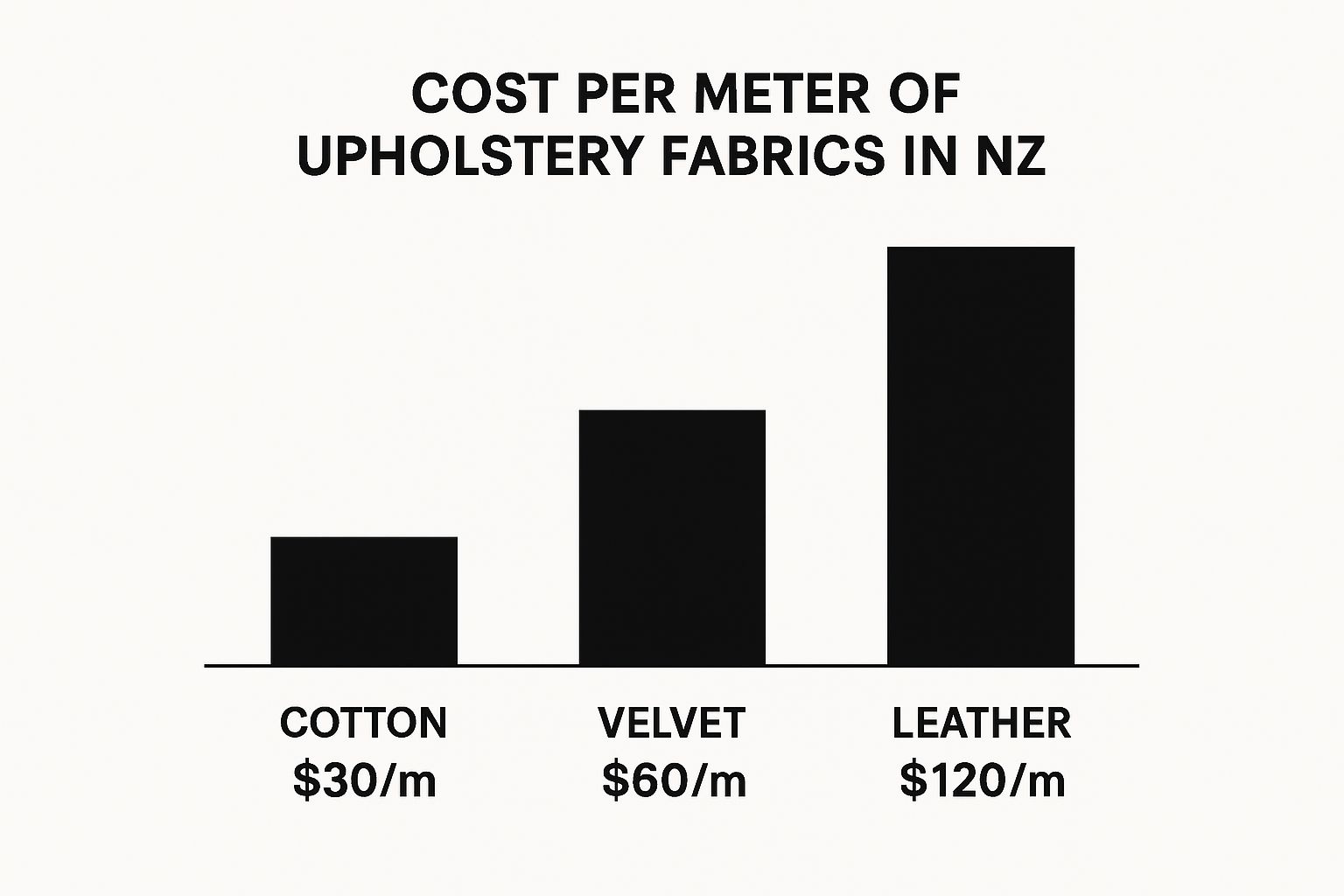
As you can see, the price per metre can vary dramatically. This just goes to show there are quality upholstery fabrics in NZ available for every project and budget.
Practical Choices for Real-Life Scenarios
Let's ground this in some real-world Kiwi situations.
Imagine you're furnishing a rental property in a student area of Dunedin. You need something that can handle serious wear and tear and is a breeze to clean. A durable, stain-resistant polyester or a hard-wearing blend is the perfect, fuss-free solution.
Or, think about a bustling cafe in Wellington. The seating has to look fantastic day in and day out, all while putting up with constant use and frequent cleaning. A PVC-coated fabric or a commercial-grade synthetic offers the ultimate mix of style, hygiene, and longevity. These materials are specifically engineered for demanding environments like these, proving their value well beyond the home.
Understanding Sustainable Upholstery Options
For many of us Kiwis, the idea of kaitiakitanga, or guardianship, is something we carry with us every day. This naturally extends to our homes, where making conscious choices just feels right. When it comes to upholstery fabrics NZ has on offer, "sustainable" is so much more than a buzzword—it's about choosing materials that are kinder to our planet without ever compromising on style or durability.
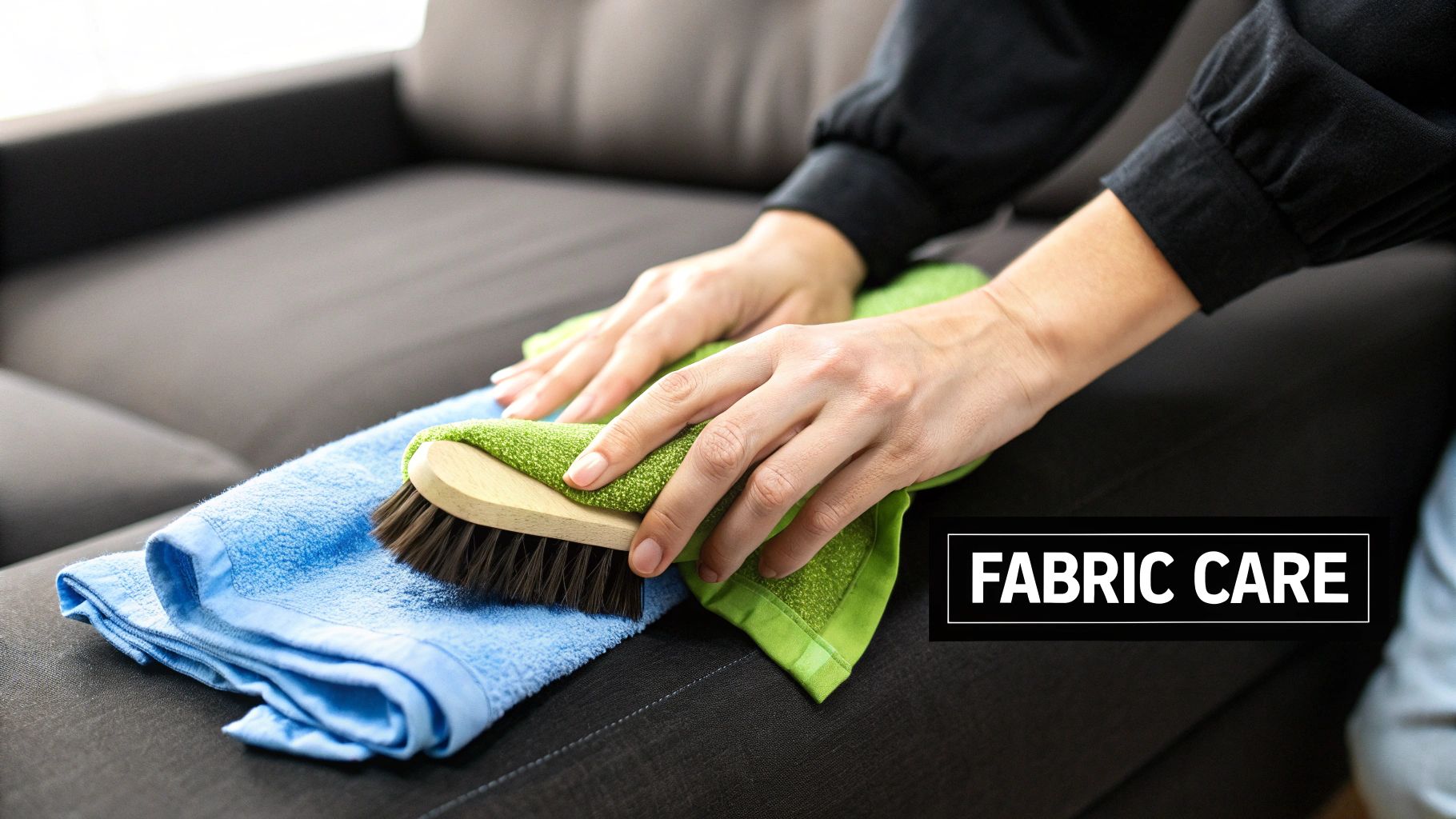
This shift towards eco-conscious living means we're looking beyond the old-school options. We’re now seeing incredible textiles made from recycled materials, organic fibres like hemp, and fabrics produced using low-impact methods. It’s all about creating beautiful spaces that we can feel genuinely good about.
What Makes an Upholstery Fabric Sustainable?
A truly sustainable fabric is one that considers its entire journey—from how it's grown and produced, to how it holds up over time, and what happens when its life is over. It’s not about finding one single "perfect" material, but about understanding the give-and-take of each option.
Here are a few things that make a textile eco-friendly:
- Renewable Resources: Fabrics made from fast-growing plants like hemp or flax (which gives us linen) are a fantastic starting point, as they can be replenished naturally.
- Recycled Content: Some of the most exciting innovations are in fabrics made from post-consumer waste, like plastic bottles. This clever approach diverts rubbish from landfills and cuts down on the need for new materials.
- Low-Impact Production: This covers processes that use less water, fewer harsh chemicals, and produce minimal waste.
- Durability and Longevity: A fabric that lasts for decades is inherently sustainable. By choosing a tough textile, you won't need to replace it as often, which saves a heap of resources in the long run.
Navigating Eco-Friendly Certifications
With so many "green" claims out there, how do you sort the good from the greenwashed? This is where trustworthy certifications come in—they act as your guide by providing independent proof of a product's eco-credentials.
Key Takeaway: Think of certifications like GOTS and OEKO-TEX as your best friends when you're shopping for sustainable textiles. They cut through the marketing fluff and give you real confidence that a fabric meets strict environmental and social standards.
These labels are a reliable shortcut to making a choice you can feel proud of.
- GOTS (Global Organic Textile Standard): This is the absolute gold standard for organic fibres. It guarantees the fabric is made from at least 70% certified organic natural fibres and that the entire process—from harvesting to manufacturing—is environmentally and socially responsible.
- OEKO-TEX® Standard 100: This label is all about health and safety. It certifies that every single component of the textile has been tested for harmful substances, meaning it’s completely safe for you and your family.
The Rise of Conscious Consumerism in NZ
Here in New Zealand, the demand for sustainable options is definitely growing, and local suppliers are stepping up. Choosing eco-friendly upholstery fabrics in NZ is a perfect way to create a healthier home. For a bit more inspiration, check out these 7 sustainable interior design ideas for 2025 that you can easily bring into your own space.
This trend is also part of a much bigger global picture. The international upholstery fabric market, currently sitting at USD 44.5 billion, is expected to nearly double. A massive driver of this growth is the increasing regulation around environmental and safety standards. While these rules are vital, they can also create new challenges for New Zealand's textile businesses, who must balance staying compliant internationally with meeting our unique local market needs.
Right, you've got the theory sorted. Now for the fun bit – actually getting your hands on the perfect fabric.
Sourcing beautiful upholstery fabric in NZ is a bit of an adventure, and knowing where to start is half the battle. Your options stretch from big national retailers to gorgeous little independent shops and a whole world of online specialists. Each offers a completely different vibe and selection.
The best approach? Dip your toes into a few different places. This way, you get a real feel for the quality, price points, and styles out there, making sure you find a textile you'll absolutely love for years to come.
National Retailers and Local Specialists
For a lot of Kiwis, the journey kicks off at a place like Spotlight. These bigger stores are fantastic for getting a broad overview. You can wander the aisles, touch everything, and see a huge range of fabrics all in one go, from budget-friendly basics to more specialised textiles.
But for that truly special find, or for some seriously knowledgeable advice, the independent fabric stores are where the magic happens.
- Auckland: As the country's design hub, you'll find plenty of specialist textile houses, often tucked away in dedicated design precincts. This is where the interior designers shop for high-end, exclusive collections.
- Wellington & Christchurch: Both cities have a thriving scene of independent fabric and craft stores. You'll often be greeted by passionate owners who can give you one-on-one guidance for your project.
These smaller shops are treasure troves, often stocking fabrics from local and international designers you simply won't see anywhere else. Perfect for finding that knockout piece.
Online Suppliers and Direct-from-Mill
The digital world has completely opened up the possibilities for sourcing upholstery fabrics in NZ. Online suppliers offer access to a massive, ever-changing inventory, often at really competitive prices. Many NZ-based online stores have quick shipping and a brilliant selection, including discounted end-of-line designer fabrics.
If you’re taking on a bigger project or have your heart set on something very specific, going direct-to-the-mill can be a great option. Some New Zealand mills sell their textiles straight to the public, which is an amazing opportunity to buy locally-made fabric right from the source.
Insider Tip: Always, always order swatches. A colour on a screen can look worlds away from how it appears in your home's unique light. A small swatch lets you see the fabric in situ, feel its true texture, and watch how the colour shifts throughout the day. It's a non-negotiable step for buying with confidence.
Shopping Smarter and Asking the Right Questions
When you’re in-store, don't be afraid to chat with the staff. They’re there to help, and their expertise can be pure gold. This is your chance to get all the details and be sure the fabric is the right fit.
Here are the key questions you should be asking:
- What is the rub count? This is the ultimate test of durability.
- What is the fabric composition? Knowing if it’s a natural fibre, synthetic, or a blend tells you a lot about how it will perform.
- Where was this fabric made? A great question for understanding its quality and story.
- What is the cleaning code? This will tell you exactly how to care for it so it lasts.
The demand for quality textiles is huge, especially since lounge and dining furniture make up the biggest slice of New Zealand's furniture wholesaling industry. While the sector has seen some challenges from cautious consumer spending, the need for beautiful, hard-wearing fabrics never goes away. You can get a deeper insight into market trends in the NZ furniture and floor covering wholesaling industry report. Armed with the right info, you’re all set to find the perfect fabric for your home.
You’ve found the perfect fabric for your space – brilliant! Now, the next step is making sure it stays looking just as good as the day it arrived.
Proper care is all about protecting your investment. Think of it less as a chore and more as a simple routine that will keep your upholstered furniture looking beautiful for years, ready to handle daily life and those inevitable "oops" moments.
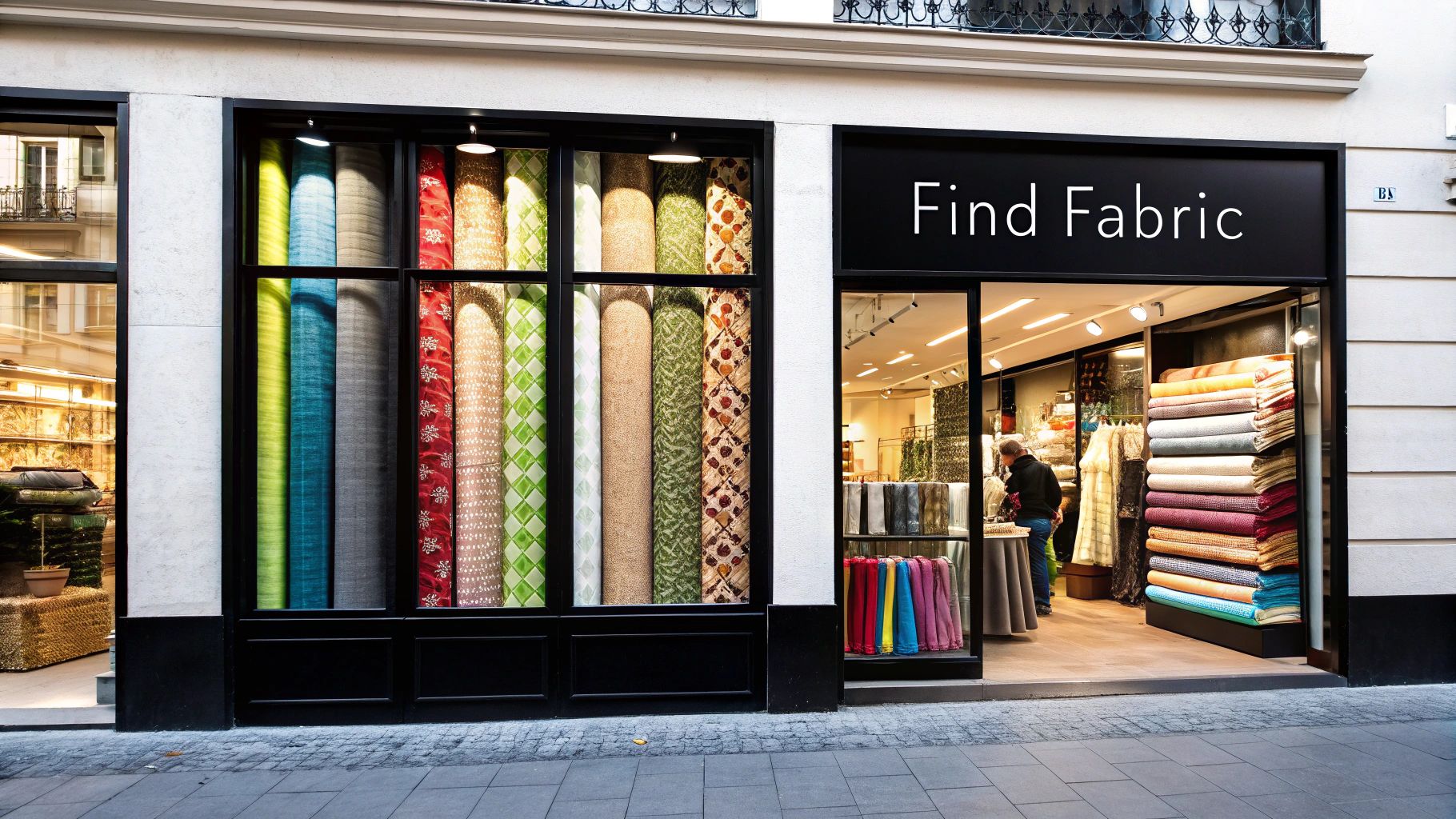
Before you do anything, the first port of call is always the cleaning code on your fabric swatch or the furniture's tag. These letters are your ultimate guide to safe and effective cleaning. Trust me, ignoring them can lead to a real disaster.
Decoding Your Fabric's Cleaning Code
These codes might look a bit cryptic at first glance, but they’re actually straightforward instructions telling you what’s safe to use on your material.
- W Code: This stands for a “Water-based cleaner.” You’re good to go with water-based shampoos or foam upholstery cleaners. This is a common code for many synthetic fibres.
- S Code: This means a “Solvent-based cleaner” is required. For these fabrics, you must use a water-free dry-cleaning solvent. Using water can cause nasty stains, shrinkage, or make the colour bleed.
- W/S Code: The best of both worlds! This code means you can safely use either a water-based or a solvent-based cleaner, giving you a bit more flexibility.
- X Code: Treat this one with extreme caution. It means no water and no solvents. Your only safe bet here is a light brush or a gentle vacuum.
Routine Maintenance for Lasting Beauty
A little bit of consistent, gentle care is the secret to making your furniture last. It stops dirt from getting ground into the fibres and keeps everything looking fresh.
- Vacuum Regularly: Once a week, grab your vacuum’s soft brush attachment and gently go over the fabric. This simple step lifts away dust, crumbs, and pet hair, preventing gritty bits from wearing down the fibres over time.
- Rotate and Fluff Cushions: If your cushions are loose, give them a flip and a rotate each week. It’s the easiest way to ensure they wear evenly and keep their shape, stopping one side from getting saggy.
- Act Fast on Spills: The moment a spill happens, blot—don’t rub! Use a clean, dry, white cloth to soak it up. Rubbing just grinds the stain deeper. Always work from the outside of the spill inward to stop it from spreading.
A Note for NZ Homes: The intense New Zealand sun can be incredibly harsh on textiles. To prevent your beautiful fabrics from fading, try to position furniture away from direct, prolonged sunlight. And for those of us in damper parts of the country, good air circulation is your best friend for stopping mildew from setting in on natural fibres.
When you’re ready for a bigger refresh, like making new cushion inserts or covers, a bit of DIY can go a long way. If you’re feeling creative, you can find a brilliant walkthrough on how to make a cushion cover with our easy DIY guide to create something that perfectly suits your style.
Your Upholstery Fabric Questions, Answered
Choosing the right fabric for a beloved piece of furniture always brings up a few last-minute questions. It's completely normal! Getting clear answers is what helps you feel truly confident in your choice, ensuring the fabric you pick is not just beautiful, but a perfect fit for your home and lifestyle.
Let's dive into some of the most common queries we hear from Kiwis getting ready to start an upholstery project.
What Is a Rub Count and What Number Do I Need?
Think of the "rub count," often called a Martindale value, as a fabric's durability score. It's a test that measures how many times a fabric can be rubbed before it starts to show wear and tear. Getting this number right is one of the keys to your furniture’s longevity.
The higher the number, the tougher the fabric. Here’s a simple way to look at it:
- For a busy, high-use family sofa, you'll want a rub count of 20,000 to 30,000 or more. This ensures it can stand up to the rigours of daily life.
- For a more decorative piece, like an accent chair in a bedroom, a count between 10,000 to 15,000 is usually perfectly fine.
Always have a look at this number to make sure the upholstery fabrics in NZ you're considering match how you live.
Are Natural Fabrics Good for the NZ Climate?
Yes, absolutely! Natural fibres like wool and linen are fantastic choices for our New Zealand climate. They offer unique benefits that synthetics just can't match.
Wool is a brilliant natural insulator, which makes it a wonderfully cosy choice for homes in the cooler parts of the country. It’s also incredibly durable and naturally flame-resistant.
Linen, on the other hand, is known for its breathability. This makes it a dream for warmer, more humid areas, as it helps keep you cool and comfortable. The only thing to be mindful of with linen is fading, so it's best to place it away from direct, harsh sunlight.
How Much Extra Fabric Should I Buy?
The golden rule in upholstery is to always buy 10-15% more fabric than your calculations say you need. This little bit of extra is your project's safety net, and it's incredibly important.
That extra meterage gives you the flexibility to perfectly line up patterns, like stripes or detailed florals, across different parts of your furniture. It also covers you for any little mistakes during cutting and leaves you with a spare piece for future repairs or even a matching scatter cushion.
Can I Use Outdoor Fabric on My Indoor Furniture?
You certainly can! In fact, using outdoor fabric indoors is a clever trick for "life-proofing" your furniture, especially in homes with kids or pets. Modern outdoor fabrics have come a long way from the stiff, plasticky materials you might remember.
Today’s performance textiles are soft, stylish, and engineered to be incredibly tough. They offer brilliant resistance to stains, moisture, and fading from our strong Kiwi sun. This makes them a wonderfully practical choice for high-traffic pieces like the family sofa or dining chairs, giving you peace of mind without sacrificing style.
Ready to find the perfect textile for your next project? At Maak Home, we offer a stunning collection of custom-printed, high-quality upholstery fabrics designed and made right here in Aotearoa. Explore our range and bring your vision to life at https://www.maakhome.co.nz.





